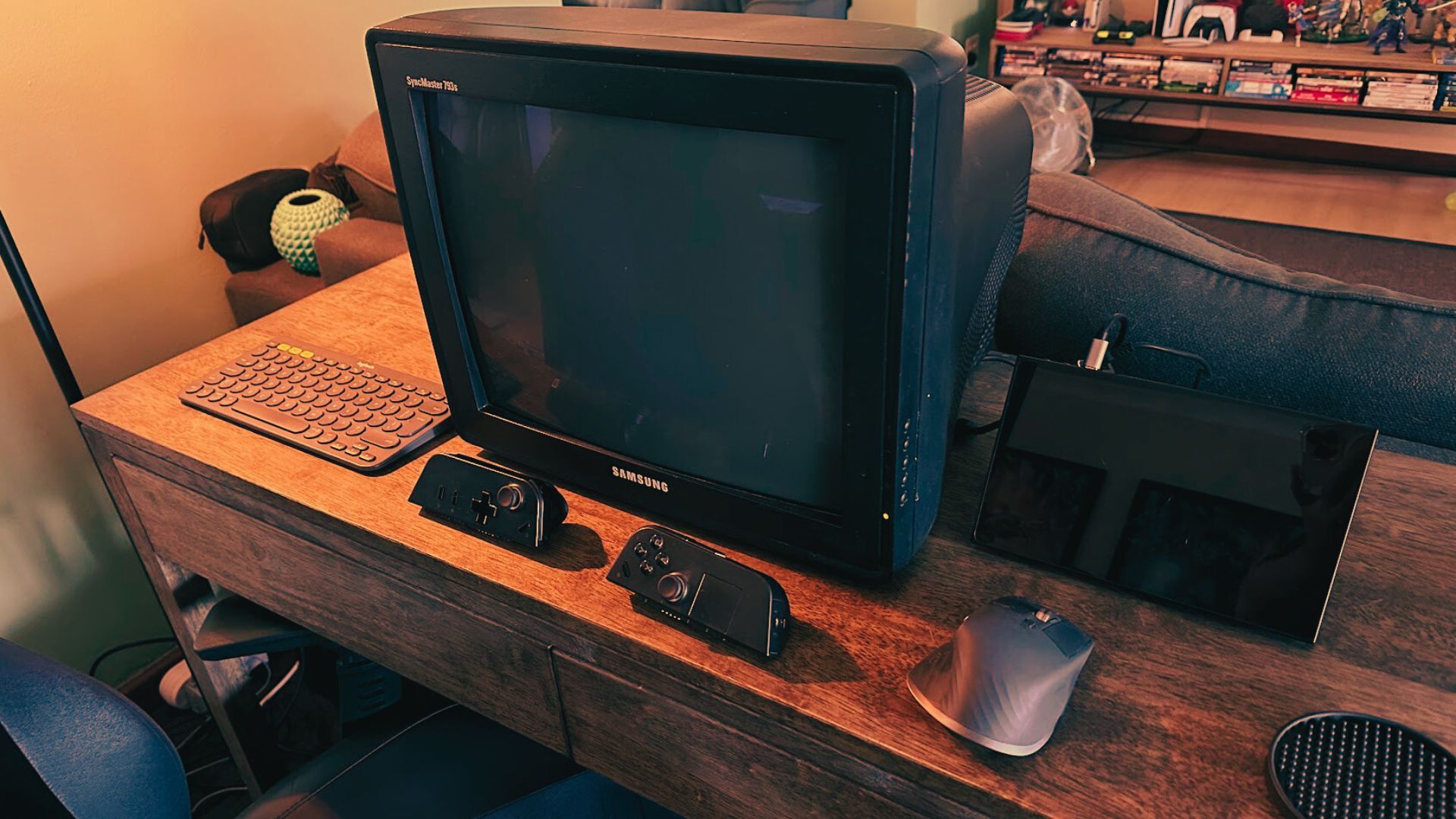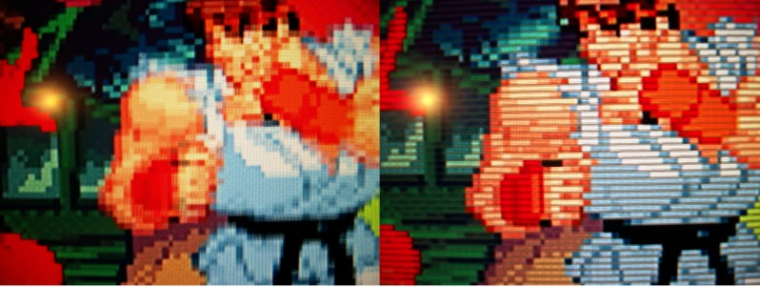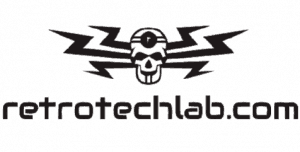
The resurgence of retro gaming has brought with it a fascinating technical challenge: how do we recreate the authentic visual experience of classic games on modern displays? The answer lies in sophisticated CRT filters and shaders that transform crisp digital pixels into the warm, organic glow that defined gaming’s golden age.
Modern LCD and OLED displays render pixels with mathematical precision, creating sharp, defined edges that were never intended by the original game developers. Classic games were designed specifically for cathode ray tube (CRT) displays, which naturally blended pixels through phosphor glow, scanlines, and subtle distortions that actually enhanced the visual experience.
This comprehensive guide explores the best CRT filters and shaders available today, focusing primarily on RetroArch’s extensive shader library. Whether you’re seeking perfect authenticity or simply want to enhance your retro gaming experience, understanding these visual technologies will transform how you experience classic games.
Table of Contents
Why CRT Filters Matter in Emulation

The importance of CRT simulation in retro gaming cannot be overstated. Original game developers worked within the constraints and characteristics of CRT technology, often using these limitations creatively to achieve effects that simply don’t translate to modern displays.
CRT monitors naturally blended adjacent pixels through phosphor persistence and electron beam characteristics. This blending effect softened harsh pixel boundaries and created smooth gradients that were integral to the artistic intent of classic games.
The Technical Foundation of CRT Display Technology
Understanding why CRT filters matter requires grasping the fundamental differences between CRT and modern display technologies. CRT displays used electron beams to excite phosphor coatings on the screen surface, creating light through chemical reactions rather than direct illumination.
This process introduced several characteristics that modern shaders attempt to replicate:
- Scanlines: Horizontal dark lines between each row of pixels, created by the gap between phosphor strips
- Phosphor glow: The warm, slightly blurred appearance of illuminated pixels that naturally anti-aliased sharp edges
- Barrel distortion: Subtle geometric warping that curved the image slightly outward from the center
- Chromatic aberration: Color fringing effects that separated RGB components slightly at high contrast edges
- Interlacing artifacts: Temporal effects from the way CRT displays drew alternating field lines

Artistic Intent and Visual Design Philosophy
Classic game artists specifically designed their pixel art with CRT characteristics in mind. Dithering patterns that look harsh and pixelated on modern displays were intended to blend smoothly on CRT screens, creating the illusion of additional colors and smooth gradients.
Many iconic visual effects from retro games depended entirely on CRT blending. Transparency effects in early console games used alternating pixel patterns that CRT displays would naturally blend into convincing semi-transparency.
The color palette choices of classic games also reflected CRT technology limitations and characteristics. Certain color combinations were chosen specifically because they would interact favorably with phosphor persistence and electron beam behavior.
Modern Display Limitations
Contemporary LCD, OLED, and other digital displays present pixels as discrete, perfectly defined squares with absolute color values. This precision, while technically superior, often undermines the visual cohesion that CRT displays provided naturally.
Sharp pixel boundaries can make classic sprite work appear crude or unfinished when viewed on modern displays. The clean, clinical presentation lacks the organic warmth that made retro games visually appealing to their original audiences.
Without proper CRT simulation, many classic games lose significant visual appeal and can appear dated in ways that were never intended by their creators. The harsh, blocky appearance of unfiltered pixel art often fails to convey the artistic sophistication that was apparent on original hardware.
Top Shaders for RetroArch

RetroArch offers the most comprehensive collection of CRT shaders available in any emulation platform. These shaders range from simple scanline filters to complex multi-pass effects that simulate every aspect of CRT display technology with remarkable accuracy.
The shader ecosystem in RetroArch is constantly evolving, with community developers continuously refining and improving these visual filters. Understanding the strengths and characteristics of each major shader family will help you choose the perfect visual treatment for your retro gaming setup.
CRT-Royale: The Authenticity Champion
CRT-Royale represents the pinnacle of CRT simulation accuracy, offering an almost overwhelming array of customization options that can recreate virtually any CRT display characteristics. This shader focuses on physically accurate simulation of electron beam behavior and phosphor response.
The shader includes sophisticated modeling of:
- Electron beam spot size and shape variations
- Phosphor persistence and decay characteristics
- Dynamic beam width adjustments
- Realistic bloom and halation effects
- Comprehensive geometry correction options
CRT-Royale’s parameter system allows users to fine-tune dozens of variables, making it possible to recreate specific CRT monitor models with remarkable precision. However, this complexity can be overwhelming for casual users and requires significant GPU resources.
CRT-Easymode: Balanced Performance and Quality
CRT-Easymode strikes an excellent balance between visual quality and performance efficiency. This shader provides convincing CRT simulation without the computational overhead of more complex alternatives, making it ideal for lower-powered systems or users who prioritize smooth performance.
Key features include:
- Efficient scanline implementation
- Adjustable mask patterns
- Simple curvature options
- Minimal performance impact
- Easy parameter adjustment
The shader’s streamlined approach focuses on the most visually impactful CRT characteristics while maintaining excellent performance across a wide range of hardware configurations.
Zfast CRT: Speed-Optimized Simulation
Zfast CRT prioritizes performance above all else, delivering basic but effective CRT simulation with minimal computational requirements. This shader is particularly valuable for handheld devices, older computers, or situations where maintaining consistent frame rates is critical.
Despite its lightweight design, Zfast CRT provides:
- Basic scanline effects
- Simple curvature simulation
- Minimal input lag
- Broad hardware compatibility
- Stable performance characteristics
CRT-Guest Advanced: Modern Excellence
CRT-Guest Advanced represents a newer generation of CRT shaders that combine traditional simulation accuracy with modern optimization techniques. This shader offers exceptional visual quality while maintaining reasonable performance requirements.
Notable features include:
- Advanced deinterlacing algorithms
- Sophisticated color processing
- Multiple mask type options
- Dynamic scanline intensity
- Comprehensive brightness controls

CRT-Lottes: Developer’s Vision
Created by Timothy Lottes, a graphics programmer with extensive experience in game development, CRT-Lottes focuses on recreating the specific visual characteristics he remembered from his own retro gaming experiences. This shader emphasizes practical authenticity over technical accuracy.
The shader excels at:
- Natural-looking phosphor simulation
- Realistic brightness gradients
- Intuitive parameter controls
- Consistent visual results
- Moderate resource requirements
CRT-Hyllian: Brazilian Innovation
Developed by the prolific shader author Hyllian, this shader brings a unique perspective to CRT simulation with innovative approaches to common visual challenges. The shader is particularly noted for its excellent handling of interlaced content and motion.
Distinctive characteristics include:
- Advanced interlacing support
- Smart motion handling
- Efficient algorithm design
- Clean parameter organization
- Reliable performance scaling
| Shader Name | Performance Impact | Customization Level | Best Use Case | GPU Requirements |
|---|---|---|---|---|
| CRT-Royale | High | Extensive | Maximum authenticity | High-end GPU |
| CRT-Easymode | Low-Medium | Moderate | Balanced experience | Mid-range GPU |
| Zfast CRT | Minimal | Basic | Performance priority | Any GPU |
| CRT-Guest Advanced | Medium | High | Modern optimization | Mid-high GPU |
| CRT-Lottes | Medium | Moderate | Nostalgic accuracy | Mid-range GPU |
Comparing Visual Effects

Understanding the visual differences between various CRT shaders requires examining how each handles the fundamental aspects of CRT simulation. The most important visual elements include scanlines, phosphor masks, geometry distortion, and color processing.
Each shader implements these effects differently, leading to distinct visual signatures that can dramatically alter the gaming experience. Some prioritize historical accuracy while others focus on creating an idealized version of CRT visuals that may be more appealing than authentic.
Scanline Implementation Comparison
Scanlines represent one of the most immediately recognizable aspects of CRT displays. Different shaders approach scanline simulation with varying levels of sophistication and realism, creating distinctly different visual impressions.
CRT-Royale implements dynamic scanlines that vary in intensity based on image brightness, closely mimicking how real CRT phosphors behaved. This creates natural-looking variations in scanline visibility that enhance visual depth and realism.
CRT-Easymode uses simpler static scanlines that maintain consistent intensity regardless of image content. While less realistic, this approach provides predictable visual results and requires minimal computational resources.
Zfast CRT employs basic scanline overlays that effectively break up the solid pixel appearance without attempting sophisticated brightness interaction. This creates a clean, recognizable CRT aesthetic with minimal processing overhead.
Phosphor Mask Varieties
Phosphor masks simulate the physical structure of CRT screens, where phosphor deposits were arranged in specific patterns to create red, green, and blue color components. Different CRT types used different mask patterns, each with distinct visual characteristics.
Aperture grille masks, used in monitors like Sony Trinitron displays, featured vertical phosphor stripes that created excellent brightness but introduced subtle vertical patterning. Many shaders offer aperture grille simulation for users seeking this specific aesthetic.
Shadow mask patterns, more common in traditional CRT televisions, used dot or slot arrangements that created different visual textures. These patterns often provided better color purity but with slightly reduced brightness compared to aperture grille designs.
Advanced shaders like CRT-Guest and CRT-Royale offer multiple mask options, allowing users to experiment with different phosphor patterns to find their preferred visual style. The choice of mask pattern can significantly impact the overall visual impression.
Geometry and Distortion Effects
Real CRT displays exhibited subtle geometric distortions due to the physics of electron beam projection onto curved screens. These distortions included barrel distortion, pincushion effects, and corner stretching that became part of the authentic CRT experience.
Some users prefer shaders that include geometric distortion for maximum authenticity, while others find these effects distracting on modern flat panels. The choice often depends on personal preference and the specific games being played.
Racing games and side-scrolling platformers often benefit from subtle curvature effects that can enhance the sense of movement and immersion. However, text-heavy games or precise action titles might be better served by geometrically accurate presentation.

Color Processing and Gamma Correction
CRT displays had specific color and gamma characteristics that differed significantly from modern LCD panels. Accurate CRT simulation requires adjusting color space, gamma curves, and brightness response to match original hardware behavior.
Many classic games were designed with CRT gamma curves in mind, meaning that colors and brightness levels that appeared correct on original hardware may look incorrect on modern displays without proper correction.
Advanced shaders include sophisticated color processing pipelines that can transform modern display output to match CRT characteristics. This includes adjustments for color temperature, saturation, and the unique brightness response curves of phosphor-based displays.
Performance vs. Quality Trade-offs
The relationship between visual quality and performance varies significantly across different shader implementations. Understanding these trade-offs helps users make informed decisions based on their hardware capabilities and visual preferences.
Multi-pass shaders like CRT-Royale achieve superior visual quality by processing the image through multiple stages, each adding specific effects like blur, brightness adjustment, or geometric distortion. However, each pass increases computational requirements exponentially.
Single-pass shaders sacrifice some visual sophistication for improved performance, making them suitable for lower-powered hardware or situations where maintaining consistent frame rates is critical.
| Visual Aspect | CRT-Royale | CRT-Easymode | Zfast CRT | CRT-Guest Advanced |
|---|---|---|---|---|
| Scanline Quality | Dynamic, realistic | Static, clean | Basic overlay | Adaptive intensity |
| Phosphor Masks | Multiple options | Limited selection | None | Comprehensive variety |
| Geometry Effects | Full simulation | Basic curvature | Minimal | Adjustable options |
| Color Accuracy | Highly accurate | Good approximation | Basic adjustment | Excellent processing |
| Customization | Extensive | Moderate | Minimal | Comprehensive |
How to Install and Customize Shaders

Installing and configuring CRT shaders in RetroArch requires understanding the platform’s shader system and file organization. The process involves downloading shader packages, configuring RetroArch settings, and fine-tuning parameters for optimal visual results.
RetroArch’s shader system is designed for flexibility and power, but this sophistication can initially seem overwhelming to new users. Following a systematic approach ensures successful shader installation and configuration.
Initial RetroArch Setup Requirements
Before installing custom shaders, ensure that RetroArch is properly configured for shader support. This includes verifying that your graphics drivers are up to date and that RetroArch has appropriate permissions to access shader files.
Required preliminary steps include:
- Install the latest RetroArch version from the official website
- Update graphics drivers to the most recent stable release
- Verify that hardware acceleration is enabled in RetroArch settings
- Ensure adequate system resources for shader processing
- Configure appropriate video driver settings (typically Vulkan or OpenGL)
The video driver selection significantly impacts shader performance and compatibility. Vulkan generally provides better performance for complex shaders, while OpenGL offers broader hardware compatibility.
Downloading and Installing Shader Packages
RetroArch shaders are distributed through the built-in online updater system, making installation straightforward for most users. However, manual installation may be necessary for custom or experimental shaders not included in the official repository.
To install shaders through RetroArch’s online updater:
- Launch RetroArch and navigate to Main Menu > Online Updater
- Select “Update Slang Shaders” for modern GPU-based shaders
- Alternatively, select “Update Glsl Shaders” for older OpenGL-compatible shaders
- Wait for the download and installation process to complete
- Restart RetroArch to ensure all shaders are properly loaded
Manual shader installation involves downloading shader files and placing them in RetroArch’s shader directory. This process requires more technical knowledge but allows access to cutting-edge or experimental shaders.
Basic Shader Configuration Process
Once shaders are installed, configuring them requires navigating RetroArch’s shader menu system. The interface provides access to shader selection, parameter adjustment, and preset management functions.
To apply a shader to your current game:
- Launch your desired game in RetroArch
- Access the Quick Menu (typically F1 or the designated hotkey)
- Navigate to Shaders > Load Shader Preset
- Browse to the CRT shader category
- Select your preferred shader (e.g., crt-royale.slangp)
- Choose “Apply Changes” to enable the shader
The shader will immediately take effect, allowing you to see the visual changes in real-time. If performance issues occur, you may need to adjust settings or select a less demanding shader.
Parameter Customization and Fine-Tuning
Most CRT shaders include numerous adjustable parameters that control various aspects of the visual simulation. Understanding these parameters enables precise customization to match your preferences and hardware capabilities.
Common adjustable parameters include:
- Scanline intensity: Controls the darkness and visibility of horizontal scanlines
- Mask strength: Adjusts the prominence of phosphor mask patterns
- Curvature amount: Determines the degree of screen geometric distortion
- Brightness/contrast: Fine-tunes overall image brightness and contrast levels
- Color temperature: Adjusts the warmth or coolness of the color palette
Parameter adjustment requires patience and experimentation to achieve optimal results. Start with default settings and make small adjustments while observing their impact on image quality.

Creating and Saving Custom Presets
Once you’ve configured shader parameters to your satisfaction, saving custom presets ensures that your settings are preserved for future gaming sessions. RetroArch supports both global and per-game shader presets.
To save shader settings:
- Configure all desired shader parameters
- Navigate to Shaders > Save in the Quick Menu
- Choose “Save Core Preset” for all games using the current emulator core
- Choose “Save Game Preset” for the current game only
- Choose “Save Global Preset” to apply settings to all games
Custom presets can be shared with other users or backed up for system migration. The preset files contain all parameter values and can be edited manually if needed.
Troubleshooting Common Installation Issues
Shader installation and configuration can encounter various technical challenges depending on hardware configuration and system setup. Understanding common issues and their solutions helps ensure successful shader deployment.
Common Issues and Solutions:
- Shaders not appearing: Verify shader files are in the correct directory and restart RetroArch
- Performance problems: Try simpler shaders or adjust video driver settings
- Visual artifacts: Check GPU driver compatibility and update if necessary
- Crashes or instability: Ensure adequate system memory and reduce shader complexity
Graphics driver incompatibility represents the most common source of shader-related problems. Ensuring that GPU drivers are current and properly configured resolves most technical issues.
Optimizing for Performance and Quality

Achieving the perfect balance between visual quality and performance requires understanding how different shader features impact system resources. Modern CRT shaders can be computationally intensive, particularly on lower-end hardware or when running demanding emulated systems.
Optimization involves finding the sweet spot where visual authenticity meets practical performance requirements. This process requires systematic testing and adjustment of various shader parameters and RetroArch settings.
Hardware Requirements and Scaling
Different CRT shaders have vastly different hardware requirements, ranging from minimal impact on system resources to demanding significant GPU processing power. Understanding these requirements helps match shaders to available hardware capabilities.
Entry-level hardware considerations:
- Integrated graphics solutions work best with lightweight shaders like Zfast CRT
- Avoid multi-pass shaders on systems with limited GPU memory
- Reduce output resolution to improve shader performance on weak hardware
- Prioritize CPU-friendly emulator cores when using GPU-intensive shaders
- Monitor thermal performance to prevent overheating during extended gaming sessions
Mid-range hardware can typically handle most single-pass CRT shaders without significant performance impact. This hardware category offers the best balance of cost and shader compatibility for most users.
High-end systems can run complex multi-pass shaders like CRT-Royale at full quality settings while maintaining consistent frame rates. These systems enable the full potential of sophisticated CRT simulation.
Resolution and Scaling Considerations
The relationship between display resolution and shader performance is complex and depends on both the specific shader implementation and the underlying emulated system. Higher resolutions increase pixel processing requirements exponentially for many shader types.
Optimal resolution strategies include:
- Use integer scaling when possible to maintain pixel accuracy
- Consider running shaders at lower internal resolutions and upscaling
- Match shader complexity to target resolution appropriately
- Test different aspect ratio settings for best visual results
- Adjust viewport settings to optimize shader rendering area
Many users find that running complex shaders at 1080p provides an excellent compromise between visual quality and performance across a wide range of hardware configurations.
Frame Rate Optimization Techniques
Maintaining consistent frame rates while using CRT shaders requires careful attention to both shader selection and RetroArch configuration. Inconsistent frame rates can significantly impact the gaming experience, particularly for timing-sensitive games.
Performance optimization strategies:
- Enable frame rate limiting to match original console specifications
- Use V-Sync or adaptive sync technologies to eliminate screen tearing
- Monitor GPU and CPU utilization during gameplay
- Adjust shader parameters to reduce computational load
- Consider reducing emulated system accuracy for better shader performance
Frame pacing consistency often matters more than raw frame rate numbers for retro gaming applications. A stable 60 FPS with occasional drops provides a better experience than variable frame rates above 60 FPS.
| Hardware Level | Recommended Shaders | Max Resolution | Key Optimizations | Expected Performance |
|---|---|---|---|---|
| Entry Level | Zfast CRT, Basic scanlines | 1080p | Reduce internal res | 60 FPS stable |
| Mid Range | CRT-Easymode, CRT-Lottes | 1440p | Balanced settings | 60 FPS with overhead |
| High End | CRT-Royale, CRT-Guest Advanced | 4K | Maximum quality | 60 FPS all settings |
| Enthusiast | Custom multi-pass | 8K | Experimental features | Variable depending on setup |
System-Specific Optimization Guidelines
Different emulated systems have varying performance characteristics that affect shader selection and optimization strategies. Understanding these differences helps tailor shader configuration for optimal results across different gaming platforms.
8-bit and 16-bit console emulation typically has minimal CPU requirements, leaving more system resources available for sophisticated shader processing. These systems often benefit most from CRT simulation since they were originally designed for CRT display characteristics.
32-bit and 64-bit console emulation requires more computational resources, potentially limiting shader complexity. However, these systems often included built-in anti-aliasing or filtering that may conflict with certain CRT shader effects.
Arcade system emulation presents unique challenges due to the variety of display technologies and resolutions used in original hardware. Some arcade games used specialized monitors that require specific shader configurations for authentic reproduction.
Memory Management and Resource Allocation
Advanced CRT shaders can consume significant GPU memory, particularly when using high-resolution textures for phosphor masks or complex lookup tables for color processing. Proper memory management ensures stable performance and prevents system crashes.
Memory optimization techniques include:
- Monitor VRAM usage during shader operation
- Reduce texture quality settings if memory constrained
- Close unnecessary background applications
- Use lighter shader variants for extended gaming sessions
- Consider system memory allocation for RetroArch processes
Systems with 4GB or less of total RAM may experience performance issues with memory-intensive shaders, particularly when running multiple applications simultaneously.
Fine-Tuning for Specific Game Types
Different genres of retro games benefit from different shader configurations and optimization approaches. Tailoring shader settings to specific game types can significantly enhance the visual experience and performance.
Platform games often benefit from strong scanline effects that enhance the perception of depth and movement. However, excessive geometric distortion can interfere with precise jumping mechanics.
RPGs and text-heavy games require careful attention to readability, often necessitating reduced shader intensity or modified color processing to maintain clear text display.
Racing and action games can benefit from more aggressive CRT simulation, including geometric distortion and bloom effects that enhance the sense of speed and immersion.

Long-term Performance Monitoring
Maintaining optimal shader performance requires ongoing monitoring and adjustment as systems age, drivers update, and shader libraries evolve. Establishing performance baselines helps identify when adjustments become necessary.
Regular maintenance practices include:
- Periodic performance testing with demanding games
- Driver update impact assessment
- Shader library updates and compatibility testing
- System temperature monitoring during extended sessions
- Storage space management for shader presets and configurations
Documenting successful shader configurations helps maintain consistent performance across system updates and hardware changes. This documentation becomes particularly valuable when migrating to new hardware or sharing configurations with other users.
The pursuit of authentic retro gaming visuals through CRT shaders represents a fascinating intersection of nostalgia and modern technology. As shader development continues to advance, the gap between simulated and authentic CRT visuals continues to narrow, offering unprecedented opportunities to experience classic games as their creators intended.
Whether you’re seeking maximum authenticity through complex multi-pass shaders or simply want to add a touch of retro warmth to your gaming experience, the extensive shader ecosystem available through RetroArch provides tools to achieve your vision. The key to success lies in understanding your hardware capabilities, experimenting with different shader options, and fine-tuning settings to match your personal preferences.
The future of CRT simulation looks bright, with ongoing development promising even more accurate and efficient shader implementations. As this technology continues to evolve, retro gaming enthusiasts will have increasingly sophisticated tools to bridge the gap between past and present, ensuring that classic games continue to captivate new generations of players with their authentic visual appeal.
